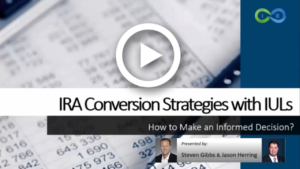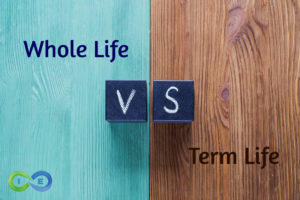Surprising comparisons, unexpected results!
You likely already know that life insurance is often purchased to help survivors pay off debts and supplement lost income when an individual passes away. But what you might not realize is that this flexible financial vehicle can be used for so much more, including college savings, healthcare and long-term care funding, tax-deferred growth, and supplementing your retirement income – possibly even on a tax-free basis!
Many people contribute to employer-sponsored savings plans like the traditional 401(k) as their primary mode of retirement planning. These plans offer many enticing features, including tax-deferred growth and the ability to convert funds into an income stream in the future.
But some life insurance policies can offer these same benefits – and then some! So, comparing the 401(k) versus life insurance could help you determine if either – or both – make sense, based on your particular objectives, risk tolerance, and time frame until retirement.
What Does the 401(k) Plan Really Offer?
A 401(k) plan is a tax-advantaged, “defined contribution” account that is offered by many employers in order to help their workers save for retirement. The type of account – 401(k) – is named after a section of the United States Internal Revenue Code.
If you participate in a traditional 401(k) plan, you will typically be eligible to do the following:
- Make pre-tax contributions (which can lower your taxable income base for the years in which you contribute)
- Have funds in the account grow tax-deferred (meaning that no taxes are due on the growth until the time of withdrawal)
- Choose from a variety of pre-selected investments and fixed accounts (which are typically chosen by the employer, and may also include shares of the employer’s stock if it is a publicly traded company)
- Receive additional “matching” contribution from your employer (usually up to a certain percentage of your own contribution)
- Borrow money from your account (note, however, that interest will be charged on the borrowed funds)
Even with all of the enticing features offered through these plans, there are some other 401(k) attributes to be aware of, because they could impact how and when you retire, as well as the amount of money that you actually have available to spend.
Potential 401 (k) Pitfalls
First, as a “defined contribution” plan, there is a set maximum amount of money that may be contributed to a 401(k). In 2022, the maximum 401(k) employee contribution for an individual who is age 49 or younger is $20,500.
If you are age 50 or older, you can add an additional $6,500 to your 2022 contribution, for a total of $27,000 for the year. For 2023, these 401(k) maximum annual contribution amounts will go up to $22,500 and $30,000 respectively. But for many investors, these contribution limits may not be enough to secure the type of retirement lifestyle they desire.
401(k) Annual Employee Contribution Limits for 2022 and 2023
| Details | 2022 | 2023 |
|---|---|---|
| Maximum employee contribution for age 49 and younger | $20,500 | $22,500 |
| Maximum "catch up" contribution for employees who are age 50 and older | $6,500 | $7,500 |
In addition, you could end up having to pay significant taxes when you access money from the traditional 401(k) account. For instance, because neither the contributions nor the gains have yet been taxed, 100% of your withdrawals will be subject to income taxation.
Even with the U.S. still languishing in a low tax rate environment, you could still see a significant portion of your 401(k) withdrawals going to Uncle Sam. Today (in 2022), the top federal income tax rate is 37%. So, depending on how much taxable income you (and your spouse, if applicable) generate, you may be required to hand over a large sum to the government at income tax time.
Income Tax Rates in 2022
| Tax Rate % | Single | Married Filing Jointly |
|---|---|---|
| 10% | Up to $10,275 | Up to $20,550 |
| 12% | $10,276 to $41,775 | $20,551 to $83,550 |
| 22% | $41,776 to $89,075 | $83,551 to $178,150 |
| 24% | $89,076 to $170,050 | $178,151 to $340,100 |
| 32% | $170,051 to $215,950 | $340,101 to $431,900 |
| 35% | $215,951 to $539,900 | $431,901 to $647,850 |
| 37% | Over $539,900 | Over $647,850 |
When the Tax Cuts and Jobs Act went into effect in 2018, it added more income tax brackets and reduced overall income tax liability for some individuals and couples. But this tax reduction won’t last forever because, for individual taxpayers, nearly all of the provisions of this act will expire at the end of 2025 – and it is much more likely that income tax rates will go up at that time (or possibly even before then) than they are to go down.
Historically, the U.S. has seen the top federal income tax rate as low as 7% and as high as 94% over the past 109 years – and in 49 of these years, this rate has been at 70% or higher. How would an increase in income tax rates like that affect your retirement lifestyle?
Top Federal Income Tax Rates 1913 – 2022
| Year | Rate | Year | Rate |
|---|---|---|---|
| 2018-2022 | 37 | 1950 | 84.36 |
| 2013-2017 | 39.6 | 1948-1949 | 82.13 |
| 2003-2012 | 35 | 1946-1947 | 86.45 |
| 2002 | 38.6 | 1944-1945 | 94 |
| 2001 | 39.1 | 1942-1943 | 88 |
| 1993-2000 | 39.6 | 1941 | 81 |
| 1991-1992 | 31 | 1940 | 81.1 |
| 1988-1990 | 28 | 1936-1939 | 79 |
| 1987 | 38.5 | 1932-1935 | 63 |
| 1982-1986 | 50 | 1930-1931 | 25 |
| 1981 | 69.125 | 1929 | 24 |
| 1971-1980 | 70 | 1925-1928 | 25 |
| 1970 | 71.75 | 1924 | 46 |
| 1969 | 77 | 1923 | 43.5 |
| 1968 | 75.25 | 1922 | 58 |
| 1965-1967 | 70 | 1919-1921 | 73 |
| 1964 | 77 | 1918 | 77 |
| 1954-1963 | 91 | 1917 | 67 |
| 1952-1953 | 92 | 1916 | 15 |
| 1951 | 91 | 1913-1915 | 7 |
On top of federal income tax, if you reside in a state that also taxes income, you’ll lose even more of your net spendable cash flow in retirement. There are only seven states (in 2022) that do not impose state income tax. These are:
- Alaska
- Florida
- Nevada
- South Dakota
- Texas
- Washington
- Wyoming
In addition to paying taxes on your 401(k) plan withdrawals, if you access funds before turning 59 ½, you may also incur an additional 10% “early withdrawal” penalty from the IRS. So, this can further reduce the amount of money that you “net” from the plan and are actually able to spend.
Depending on the amount of taxable income you generate from your 401(k) plan withdrawals, it could also have an impact on whether or not other sources of your retirement income is considered taxable.
For instance, many people are not aware that up to 85% of their Social Security retirement income benefits may be taxable. The amount of taxable Social Security income is based on how much taxable income you generate from other sources.
In this case, there are several factors that could make your Social Security retirement benefits subject to income tax. These can include the following situations:
- Whether or not you have reached your full retirement age (FRA) when you file for your Social Security retirement benefits
- The amount of income (if any) that you receive from other sources
Social Security Full Retirement Age
| The year you were born: | Your full retirement age (FRA) for Social Security benefits: |
|---|---|
| 1943 - 1954 | 66 |
| 1955 | 66 and 2 months |
| 1956 | 66 and 4 months |
| 1957 | 66 and 6 months |
| 1958 | 66 and 8 months |
| 1959 | 66 and 10 months |
| 1960 or after | 67 |
So, based on your particular situation, you might be required to pay tax on a percent of your Social Security benefits (in 2022), if you meet one of the following:
- You file your federal income tax return as an individual taxpayer, and your combined income is:
- Between $25,000 and $34,000 (if so, up to 50% of your Social Security retirement income benefits could be taxable)
- More than $34,000 (if this is the case, up to 85% of your Social Security benefits may be taxable)
- You file a joint income tax return with your spouse, and you have a combined income that is:
- Between $32,000 and $44,000 (if so, then up to 50% of your benefits may be taxable)
- More than $44,000 (in this case, up to 85% of your Social Security retirement income benefits may be taxable)
- You are married and you file a separate tax return.
The amount of your combined income is equal to your adjusted gross income plus any non-taxable interest earned, plus one-half of your Social Security benefits.
Some retirees do not need to access money from their 401(k) plan in retirement. But, while you may be tempted to leave the funds alone so that they can continue generating tax-deferred growth, there comes a point where the IRS will force you to make withdrawals (or else you will be penalized).
Under the required minimum distribution (RMD) rules, you are required to start taking at least a certain amount out of traditional 401(k)s – as well as other traditional retirement plans and IRA accounts – at age 72.
If you do not make these required withdrawals, you will be penalized at a rate of 50% of the amount that should have been withdrawn. So, for example, if your required minimum distribution for a given year is $25,000, but you do not make the withdrawal, the penalty would be $12,500.
RMD amount = $25,000
Penalty = 50% X $25,000
Penalty = $12,500
Regardless of whether you are still working, or you’re retired and taking withdrawals from your 401(k), as long as any of your funds are invested in equities, you could run the risk of losing value in the account. This, in turn, can reduce the income-generating base that you have, and likewise, increase the chances of your plan running out of money faster.
In fact, any time an investment incurs a negative return, it can take a higher positive return just for it to get back to even. As an example, if your account value is $100,000, and you incur a loss of 50% in a given year, the account value will drop to $50,000.
If you generate a positive return of 50% the following year, though, the value of the account will not go back to $100,000. Rather it will only go to $75,000. This is because 50% of $50,000 is $25,000.
Year 1: $100,000 – 50% = $50,000
Year 2: $50,000 + 50% = $75,000
Alternate Year 2: $50,000 + 100% = $100,000
When it comes to losses in your portfolio or investments, the more you lose, the higher the future return needs to be in order to get the account back to even – and there are no guarantees that this will ever happen.
Percent Loss vs. Percent Needed to Recover
| Percent Loss of Account Value | Percent of Gain Needed to Recoup the Loss |
|---|---|
| 10% | 11.11% |
| 20% | 25% |
| 30% | 42.85% |
| 40% | 66.66% |
| 50% | 100% |
| 60% | 150% |
| 70% | 233% |
| 80% | 400% |
| 90% | 900% |
| 100% | Broke |
Generating any losses in an investment account could lead to a decreased account value – even if the “average” return isn’t negative. Take, for instance, an account that has an average return of 0% over a ten year period of time. At the end of Year 10, though, the account could still have an actual value of (- 5%).
| End of Year | Gain or Loss | Value of Account |
|---|---|---|
| 1 | 10% | $1,000.00 |
| 2 | (-10%) | $990.00 |
| 3 | 10% | $1,089.00 |
| 4 | (-10%) | $980.10 |
| 5 | 10% | $1,078.11 |
| 6 | (-10%) | $970.30 |
| 7 | 10% | $1,067.33 |
| 8 | (-10%) | $960.60 |
| 9 | 10% | $1,056.66 |
| 10 | (-10%) | $950.99 |
This is why it can often make more sense to gravitate towards financial vehicles that provide lower annual returns, but that also guarantee protection of principal in any type of market environment. This is why life insurance could be an option for your retirement portfolio.
Traditional 401(k) Pros and Cons
| Traditional 401(k) Advantages | Traditional 401(k) Drawbacks |
|---|---|
| Pre-tax contributions | Withdrawals are usually 100% taxable |
| Tax-deferred growth | Required Minimum Distributions (RMDs) |
| Employer matching contributions | Maximum annual contributions |
| Ability to borrow funds | Interest charged on loan - and taxed as a distribution if not repaid |
| Withdrawals may cause taxation of Social Security income | Can incur market-related risk |
The Benefits of Life Insurance vs 401k
While it might seem to be an unlikely asset to use for retirement planning, life insurance can actually provide you with a number of benefits – including various guarantees – that can help create a more financially secure retirement for you and your loved ones.
Using a properly structured cash value life insurance policy allows you to build up cash value on a tax-deferred basis, while at the same time ensuring that if the unexpected occurs, your loved ones will receive a lump sum of money, free of income taxation. These funds can be used for any number of needs and wants, such as:
- Income replacement
- Debt payoff
- College funding
- Funeral / final expenses
- Estate taxes
- Taxes on asset transfers
- Replacement of lost retirement benefits for a surviving spouse (such as a pension income that stops at the death of the first spouse to pass on)
- Charitable contributions
Although permanent life insurance will typically cost more in premium than a term life policy (with all other factors being equal), the amount of the premium will typically not to go up with the permanent life option. In fact, with whole life insurance, the premium is guaranteed to remain the same throughout the entirety of the policy.
This differs from term life insurance which offers only death benefit protection – and no cash value build-up – for a set period of time, such as 10 years, 20 years, or 30 years. If a term insurance policy is renewed, the new premium will usually be higher.
As its name implies, permanent life insurance is often purchased for more permanent coverage needs, such as estate planning and/or income replacement for survivors, as opposed to “temporary” needs like the payoff of a 30-year mortgage balance or college funding for a child or grandchild.
In the early years of a permanent life insurance policy, a surrender – or early withdrawal – charge may be incurred if money is accessed before a certain amount of time has elapsed. Taxes on gains that are withdrawn will also be incurred.
IULs
Depending on which type of permanent life insurance policy you choose, you could reap some added benefits, too. For example, an indexed universal life insurance policy includes a cash value component that earns its return primarily based on the returns of an underlying market index (such as the S&P 500 or the Dow Jones Industrial Average). This gives you the opportunity to obtain market-linked returns – usually up to a specified maximum, or “cap.”
But, if the underlying market index performs poorly in a given contract period (such as a policy year), your funds don’t lose value. In fact, the worst that you can do is 0%…even if the index or the market tanks by double digits in a given time period.
So, given that the account value can go up in years where the underlying index(es) performed positively, coupled with no losses in the years when the underlying investments performed poorly, there would never be a decrease in the account value.
| End of Year | Gain or Loss | Value of Account |
|---|---|---|
| 1 | 10% | $1,100 |
| 2 | 0% | $1,100 |
| 3 | 10% | $1,210 |
| 4 | 0% | $1,210 |
| 5 | 10% | $1,331 |
| 6 | 0% | $1,331 |
| 7 | 10% | $1,464 |
| 8 | 0% | $1,464 |
| 9 | 10% | $1,611 |
| 10 | 0% | $1,611 |
Therefore, the two accounts in the examples shown above performed very differently – even in the exact same market conditions. Plus, in addition to the protection of principal that the indexed universal life insurance policy offers, it also includes a feature called “annual reset.”
This allows you to “lock in” gains each year, never to be lost – regardless of future market volatility. With that in mind, there is no need to “get back to even” before your account can start generating positive returns again following a down period.
With that in mind, cash value life insurance can offer a “best of both worlds” scenario by allowing for both growth and protection. In addition to indexed universal life, another possible option for your retirement portfolio is whole life insurance.
Whole Life
Whole life insurance is also a type of permanent coverage that offers death benefit protection, as well as a cash value, or savings, component. Once an insured is approved for whole life insurance, the policy will remain in force for as long as the premium is paid.
If the insured dies while the whole life policy is in force, the death benefit will be paid to one or more named beneficiaries. Death benefit proceeds are usually free of income taxation to the recipient(s).
The funds that are in the cash value of a whole life insurance policy also grow tax deferred, so there is no tax due on the gain unless or until it is withdrawn. While many investors seek financial vehicles that have the “opportunity” for substantial returns, a whole life insurance policy – given its protection of principal and tax-deferred growth – could actually outperform many investments, even if it generates a low annual return.
For instance, consider the examples above with the investments that fluctuate each year between high positive returns, as well as significant negative returns. Then, compare that with a cash component that offers just a 2% annual return, but with no losses and tax-deferred growth.
2% Compound Return, Tax-Deferred for 10 Years
Initial Account Value = $10,000
| End of Year 1 | $10,200 |
| End of Year 2 | $10,404 |
| End of Year 3 | $10,612 |
| End of Year 4 | $10,824 |
| End of Year 5 | $11,041 |
| End of Year 6 | $11,262 |
| End of Year 7 | $11,487 |
| End of Year 8 | $11,717 |
| End of Year 9 | $11,951 |
| End of Year 10 | $12,190 |
Similar to indexed universal life insurance policyholders, whole life insurance policyholders may also either withdraw or borrow cash from the policy that can be used to supplement future retirement income.
On top of the tax-deferred growth, principal protection, and tax-free loan features, there are some other benefits that life insurance can offer, too, when it is used in retirement planning.
Life Insurance Benefits can include the following:
- No IRS “early withdrawal” penalty – Unlike a 401(k) plan, the IRS will not penalize you for taking distributions from the cash value prior to age 59 ½.
- No maximum annual contribution limit – Also unlike 401(k)s, there is no limit on how much you can contribute to a life insurance policy each year. So, even if you have “maxed out” the yearly contribution on your 401(k), you can still contribute to a life insurance policy.
- No Required Minimum Distribution (RMD) rules – While traditional 401(k) plans enforce required minimum distributions at age 72, this is not the case with life insurance. Therefore, if you do not need the money, you can leave it in the policy to continue generating tax-advantaged growth.
- Policy loans have no impact on the taxation of Social Security benefits – Because life insurance loans are not taxable, they won’t negatively impact the potential taxation of your Social Security retirement income benefits.
- Protection from creditors – In many cases, the funds that are in your life insurance policy’s cash value are protected from creditors, as well as bankruptcy and lawsuits.
- A “self-completing” plan – Because of the death benefit that is associated with life insurance, these plans are considered “self-completing,” meaning that even in the event that the insured passes away, their survivors will still be protected financially with the policy’s income-tax free death benefit.
Permanent Life Insurance Pros and Cons
| Permanent Life Insurance Advantages | Permanent Life Insurance Drawbacks |
|---|---|
| Income-tax free death benefit for survivors | Must qualify for the coverage |
| Premium typically remains the same amount throughout the life of the policy | Surrender charges are typically imposed in the early years of the policy |
| Tax-deferred growth of cash value | Cost of permanent coverage is usually more than a comparable term life insurance policy |
| Principal protection (in any market environment) | Policy could lapse if the premium is not paid |
| No annual maximum contributions | Can take some time for the cash value to grow |
| No required minimum distribution (RMD) rules | |
| No 10% IRS early withdrawal penalty if withdrawals are taken prior to age 59 ½ | |
| Tax-free policy loans (and 100% of the cash value continues to generate a return) | |
| Protected from creditors and bankruptcy |
Items to Consider with 401(k) Plans vs Life Insurance
There are many ways to save and invest for retirement. If you (and/or your spouse) work for a company that offers an employer-sponsored retirement plan, you may already be taking advantage of the benefits that a traditional 401(k) can offer.
Another way to plan – or to supplement your plan – for retirement is through a properly-structured life insurance policy. Although using permanent life insurance with retirement planning may not be suitable for everyone, it can make a big difference for others. With that in mind, some of the most important issues to consider when comparing 401(k) plans with permanent life insurance include the following:
- Contributions / premiums
- Annual contribution limits
- Growth of the funds in the account
- Fees
- Early withdrawal penalties
- Required minimum distributions
- Taxability of withdrawals
- Loan provisions
There can be many “moving parts” associated with any type of financial or retirement planning. So, it can help if you discuss your specific objectives, as well as your risk tolerance, and time frame until retirement with a specialist who can guide you in the right direction.
Traditional 401(k)s versus Life Insurance
| Traditional 401(k) Plans | Life Insurance | |
|---|---|---|
| Contributions | Pre-tax dollars | After-tax dollars |
| Annual contribution limit | Annual maximum contributions (may be more, based on age) | No annual maximum contribution limit |
| Growth of funds in the account | Tax-deferred growth | Tax-deferred growth |
| Risk | Subject to market risk (depending on investment options and diversification) | Risk is typically "capped," depending on the policy |
| Fees / Early withdrawal penalties | Possible fees may include: * Investment management fees; *Early withdrawal penalty (if under age 59 ½) | Surrender charges in the early years of the policy |
| Required Minimum Distributions | IRS required minimum distributions must begin at age 72 | No required minimum distribution at any age |
| Taxability of withdrawals | 100% taxable | Gain is taxable; return of contributions is tax-free |
| Loan provisions | Interest is charged on the loan. Funds borrowed from the account do not continue to generate a return. If loan is not repaid, it is taxed as a plan distribution. | Loans are tax-free. Because the cash value is only used as collateral, interest continues to accrue on the entire cash value account balance. If loan is not repaid, it will be covered by death benefit proceeds at the insured's passing. |
How to Find the Best Life Insurance Policy for Your Specific Objectives
If you determine that life insurance is right for you, it is important to find the best policy for your specific needs and goals. Not all life insurance is the same. In fact, many policies can differ in the way that they provide a return on the cash value (if they even offer a cash component), as well as their qualification criteria, and the cost of the premium.
Given that, be sure to do the following before you make a long-term commitment to any type of life insurance policy:
- Compare the premium cost with at least 2-3 insurance carriers
- Check the financial strength ratings for the offering insurance company (carriers are typically rated by A.M. Best, Standard & Poor’s, Moody’s, and/or Fitch Ratings)
- Underwriting criteria
- Better Business Bureau grade
- Customer reviews / testimonials
- Company history
- Reputation for paying claims to policy holders
Do You Have the Most Comprehensive Retirement Plan in Place?
If you participate in an employer-sponsored 401(k) plan, you may be building up a nice nest egg for the future. But there could be ways to further enhance your retirement lifestyle. One way is to add a properly structured permanent life insurance policy to your plan.
So, if you would like more information regarding whether or not this is the right strategy for you, feel free to contact the specialists at Insurance and Estates who can show you how you could increase your retirement planning options and set up a tax-free retirement income in the future.
You can reach Insurance and Estates by calling (877) 787-7558 or by sending us an email through our secure online server at info@insuranceandestates.com. We look forward to helping you grow and protect assets to ensure a secure financial future.






